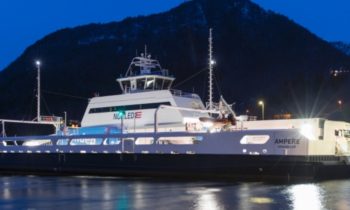 The world’s first electrically powered fishing boat will be presented this August in Trondheim, Norway. But more time and development is needed before it can run completely without diesel. “We hope to pass Vestfjorden fossil-free on 23 August. We will exhibit the week before at the Aqua Nor/ Nor Fishing Trade Fair,” says Erik Ianssen.Ianssen is the general manager of Selfa Arctic. This boat-building outfit has spent the last seven years working on a hybrid version of small fishing boat, a type known in Norway as a sjark – in English, a small smack.
The world’s first electrically powered fishing boat will be presented this August in Trondheim, Norway. But more time and development is needed before it can run completely without diesel. “We hope to pass Vestfjorden fossil-free on 23 August. We will exhibit the week before at the Aqua Nor/ Nor Fishing Trade Fair,” says Erik Ianssen.Ianssen is the general manager of Selfa Arctic. This boat-building outfit has spent the last seven years working on a hybrid version of small fishing boat, a type known in Norway as a sjark – in English, a small smack.
Over 70 percent renewable
“These are known components which have been configured in a novel way,” he explains.
“We have built small smacks since the 1970s. Things we’ve always taken for granted need to be seen in a completely new light with an electric motor.”
“The basic demand is for the electricity to cover a day of fishing, from morning to evening. But the generator might have to be fired up if the boat needs to go further out to sea, or the weather is rough or the boat catches more fish than expected. But at least 70 percent of the expended energy should be renewable,” says Erik Ianssen.
Not yet profitable
This is easier said than done and it will be a long time before fishermen can operate fully without diesel:
“Right now it’s unprofitable because the batteries are just far too dear. We figure that within about five years they will get cheaper and more commercially viable,” says Roar Pedersen.
He heads up a department concerned with vessel technology at FHF – the Norwegian Seafood Research Fund.
32,000 tonnes CO2
The research company Sintef, headquartered in Trondheim, has analysed the energy consumption of a small smack and arrived at the battery capacity one needs to run electrically in the fishing grounds.
The batteries also need to last 25 years – as long as a normal diesel engine. If all the small commercial fishing boats were to run on batteries, Norway’s annual carbon dioxide emissions would be reduced by 80,000 tonnes. As hybrids, using diesel motors to assist in getting back and forth to fishing grounds, the reduction would be 32,000 tonnes. Another advantage is that fishermen would gain a better work environment with less fumes and noise.
Coastal fleet
“The boats would be capable of generating electricity with the help of diesel motors on the way to and from the fishing grounds,” says Pedersen. As for ocean fishing, where vessels are out to sea for days on end, he doesn’t think electric power is a solution. But natural gas or biogas could be a greener alternative than diesel.
Electrical power is a real option for the coastal fishing fleet:
“We have hydroelectric power and very good conditions for expanding the use of wind power. We can produce as much green energy as we want to in this country,” points out Pedersen. The technology used by the electric fishing boats could also be used by service vessels which the aquaculture industry uses between shore and the fish farm facilities out in the fjords and coastal waters.
“We are witnessing the developments in the auto industry and big numbers of EVs that are being sold here in Norway. Sales have skyrocketed. And battery technology is developing rapidly.”
Difficult to find hard-cost money
Why hasn’t there been an E-small smack before now, when electric vehicles have become so popular? Erik Ianssen at Selfa Arctic is critical of the way research funds are prioritised in Norway:
“We have had the concept. But it is very expensive. The framework conditions in Norway are a real problem, as you have to do the funding out of pocket. Soft-cost allocations flow freely for researchers sit around and scratch their heads with, but it’s pretty difficult to get hard-cost funds for real things,” he says.
“We received NOK 7 million [about $1 million] for a research project about how such a boat would handle. It’s easier to attract such funding. But getting anything to build the boat to experiment with is nearly impossible.”
Not in denial
Roar Pedersen at FHF thinks this criticism is justified:
“It’s true. It’s harder to get risk relief. FHF is prepared to give support to technology providers who develop new technology. But these are often soft costs too, and don’t go toward construction outlays,” he says.
“We can give some support if a fisherman wants to invest in something like this and feels there is a risk involved. The way it works is the fisherman is given some relief to lower risks, which makes it easier for the supplier to sell the product,” says Pedersen.
